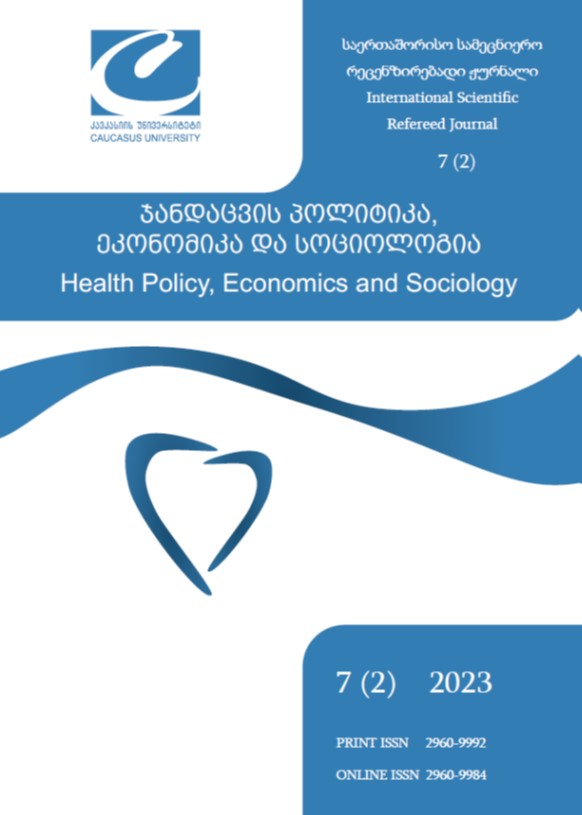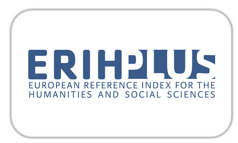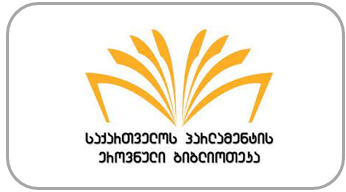Health characteristics of women of reproductive age in ethnic minorities
DOI:
https://doi.org/10.52340/healthecosoc.2023.07.02.03Keywords:
fertility, stillbirth, stigma, abortion, reproductive health, ethnic minoritiesAbstract
Introduction: The health of women of reproductive age is influenced by social determinants, including economic status, religion, education, employment, and living conditions. Ethnic minority women and girls face additional challenges due to cultural differences, religion, language barriers, ethnic identity, and the stigma associated with their identity. The purpose of our research is to study the characteristics of sexual and reproductive health of women and girls from small ethnic groups, the Armenian and Azerbaijani populations living in Georgia, to determine the factors affecting their health, and to outline the main key issues. Methodology: qualitative research methods were used. An in-depth interview was conducted with doctors (gynecologists, family doctors, and therapists) employed in densely populated regions with Armenian and Azerbaijani populations (Samtskhe-Javakheti and Kvemo Kartli). Statistical information from the National Center for Disease Control and the National Statistical Service was processed. Results and discussion: the study showed that women in both ethnic groups do not prioritize their own health, so delayed referrals to doctors and aggravated forms of the disease are frequent. Language and cultural barriers often negatively affect the outcome of the disease. There is hiding of symptoms and diagnosis from the doctor, which is sometimes related to identity. There is neglect of women's bodily autonomy and interference by other people in the decision-making process. Interest in the human papillomavirus vaccine is low. The age of initiation of sexual life and childbearing is mostly low. We encounter marriages of minors and pregnancy, which endangers their health as well as the health of the fetus. The stillbirth rate is high. Birth rates and natural increase rates are high because large families are culturally encouraged. Consanguineous marriages occur, which increases the risk of provoking the inheritance of recessive genetic disorders in the offspring. Knowledge and awareness about modern methods of contraception are low; there is a social taboo and a conservative attitude towards condoms. The number of artificial abortions is high, including the selective abortions. The prevalence of sexually transmitted diseases is high, and awareness about these diseases is low. Conclusion: A number of socio-cultural factors, mainly gender norms, and stigma related to sexuality, harm women's sexual and reproductive health. While some circumstances are common to the general population living in Georgia, other experiences are unique, indicating the necessity for distinct approaches to protect the sexual and reproductive health of the target group.
References
დაავადებათა კონტროლის და საზოგადოებრივი ჯანმრთელობის ეროვნული ცენტრი. (2022). 2022 წელს დაფიქსირებული დედის საშუალო ასაკი დაბადებისას დაწესებულებების მუნიციპალიტეტების მიხედვით.
დაავადებათა კონტროლის და საზოგადოებრივი ჯანმრთელობის ეროვნული ცენტრი. (2022). 2022 წელს რეგისტრირებული აბორტების რაოდენობა.
დემოკრატიისა და მმართველობის ცენტრი. (2022). ადრეული/ბავშვობის ასაკში ქორწინების საზიანო პრაქტიკა საქართველოში. გვ 36-41 https://georgia.unfpa.org/sites/default/files/pub-pdf/bavshvobis_asakshi_korcineba_angarishi_saboloo_versia.pdf
მიქელაძე, ა. (2016). მარხვა, რამაზანი. https://www.muslimgeorgia.com/rezo-aziz-mikeladze/%e1%83%9b%e1%83%90%e1%83%a0%e1%83%ae%e1%83%95%e1%83%90-3/
საქართველოს საკანონმდებლო მაცნე. (11,10,2017). საქართველოს დედათა და ახალშობილთა ჯანმრთელობის ხელშეწყობის 2017-2030 წლების ეროვნული სტრატეგიისა და მისი განხორციელების 2017-2019 წლების სამოქმედო გეგმის დამტკიცების თაობაზე. https://matsne.gov.ge/ka/document/view/3825285?publication=0
საქართველოს სახალხო დამცველი. (2019). სექსუალური და რეპროდუქციული ჯანმრთელობა და უფლებები, ეროვნული შეფასება. https://ombudsman.ge/res/docs/2019072913513745197.pdf
საქართველოს სტატისტიკის ეროვნული სამსახური. (2014). მოსახლეობის განაწილება რეგიონებისა და ეროვნებების/ეთნიკური წარმომავლობის მიხედვით. Retrieved from მოსახლეობის 2014 წლის საყოველთაო აღწერის შედეგები: https://www.geostat.ge/ka/modules/categories/739/demografiuli-da-sotsialuri-makhasiateblebi
საქართველოს სტატისტიკის ეროვნული სამსახური. (2022). დედათა გარდაცვალების რიცხოვნობა რეგიონების მიხედვით. მოსახლეობა და დემოგრაფია: https://www.geostat.ge/ka/modules/categories/320/gardatsvaleba
საქართველოს სტატისტიკის ეროვნული სამსახური. (2022). მოსახლეობა და დემოგრაფია. ბუნებრივი მატება რეგიონების და თვითმმართველი ერთეულების მიხედვით: https://www.geostat.ge/ka/modules/categories/321/bunebrivi-mateba
საქართველოს სტატისტიკის ეროვნული სამსახური. (2022). მოსახლეობა და დემოგრაფია. ცოცხლად დაბადებულთა რიცხოვნობა რეგიონების და თვითმმართველი ერთეულების მიხედვით: https://www.geostat.ge/ka/modules/categories/319/dabadeba
საქართველოს სტატისტიკის ეროვნული სამსახური. (2022). მოსახლეობა და დემოგრაფია. მკვდრადშობილთა რიცხოვნობა რეგიონების და თვითმმართველი ერთეულების მიხედვით: https://www.geostat.ge/ka/modules/categories/319/dabadeba
საქართველოს სტატისტიკის ეროვნული სამსახური. (2022). მოსახლეობა და დემოგრაფია, მოსახლეობის რიცხვოვნობა რეგიონების და თვითმმართველი ერთეულების მიხედვით. საქართველოს სტატისტიკის ეროვნული სამსახური: https://www.geostat.ge/ka/modules/categories/316/mosakhleoba-da-demografia
საქართველოს სტატისტიკის ეროვნული სამსახური. (2022). ცოცხლად დაბადებულთა რიცხოვნობა რეგიონების და სქესის მიხედვით. Retrieved from მოსახლეობა და დემოგრაფია: https://www.geostat.ge/ka/modules/categories/319/dabadeba
სოციალური სამართლიანობის ცენტრი. (2022). ეთნიკური უმცირესობების სოციალური და ეკონომიკური ექსკლუზია. გვ.8 https://socialjustice.org.ge/ka/products/etnikuri-umtsiresobebis-sotsialuri-da-ekonomikuri-ekskluzia
UNFPA გაეროს მოსახლეობის ფონდი. (2022). ადამიანის სექსუალობის შესახებ განათლების მიმოხილვა საქართველოში. გვ.7 Retrieved from გაეროს მოსახლეობის ფონდი: https://georgia.unfpa.org/sites/default/files/pub-pdf/sexuality_aducation._pages.pdf
UNFPA გაეროს მოსახლეობის ფონდი. (2022). საქართველოში არადომინანტი ეთნიკური ჯგუფების წარმომადგენელი ქალებისა და გოგოების სექსუალური და რეპროდუქციული ჯანმრთელობის და უფლებების კუთხით არსებული მდგომარეობის შეფასება. გვ 5-6 Retrieved from https://georgia.unfpa.org/sites/default/files/pub-pdf/2022042614550415532.pdf
WeResearch, ფრიდრიხ ებერტის ფონდი . (2021). ორმაგი დაუცველობა და უსაფრთხოება, ეთნიკურად აზერბაიჯანელ და სომეხ ქალთა შემთხვევის შესწავლა საქართველოში. გვ.2 Retrieved from https://library.fes.de/pdf-files/bueros/georgien/18830.pdf
World health organization. (2021). HRP annual report 2021. Retrieved from Sexual and Reproductive Health and Research: https://www.who.int/publications/i/item/9789240051003
World health organization. (2021). Sexual and Reproductive Health and Research (SRH). Retrieved from World health organization: https://www.who.int/teams/sexual-and-reproductive-health-and-research-(srh)
Downloads
Published
Versions
- 2023-12-09 (2)
- 2023-08-03 (1)
How to Cite
Issue
Section
License

This work is licensed under a Creative Commons Attribution-ShareAlike 4.0 International License.













